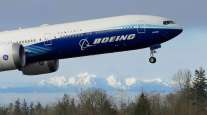Bloomberg News
Boeing’s Year-End Goal for 737 Max Return Gets Boost in Europe

[Ensure you have all the info you need in these unprecedented times. Subscribe now.]
Boeing Co.’s push to return the grounded 737 Max jet to the skies by year’s end got a boost from European regulators, who said they expect to sign off on their safety review by November.
Test flights and a separate round of simulator sessions conducted this month went well, Patrick Ky, executive director of European Union Aviation Safety Agency, told French reporters on Sept. 25. EASA expects to lift its grounding shortly after the U.S. Federal Aviation Administration, Ky said. He expects Chinese authorities to take longer to allow the plane back in the air.
Boeing has agreed to install a synthetic sensor on the next version of the plane, called the 737 Max 10, according to Ky, whose comments were confirmed by EASA. Existing models will be retrofitted after the jet’s return, he said.
Boeing has worked with regulators to get the 737 Max back in the air following the crashes that killed 346 people and led to a worldwide grounding of the jet in March 2019. While the FAA is the main certification body for the plane, gaining EASA’s approval is seen as a key milestone for its return outside the U.S., after other global regulators signaled they would follow the European agency’s lead.

What does it take to be a commercial driver, and what are schools doing to train them? Host Michael Freeze speaks with Chris Thropp of Sage Truck Driving School and Don Lefeve of the Commercial Vehicle Training Association. Hear a snippet, above, and get the full program by going to RoadSigns.TTNews.com.
The agreement on a synthetic sensor resolves a key concern of EASA that went beyond fixes that the FAA had proposed. The European regulators wanted more redundancy for so-called angle-of-attack sensors that were a factor in the two crashes.
EASA has also asked for Boeing to give pilots a way to disable the so-called stick shaker alarm system, Ky said. Canadian regulators also have raised concerns about multiple alarms potentially confusing pilots in an emergency.
FAA Review
The FAA has proposed multiple changes to the aircraft before allowing it to carry passengers again. Among them, the system that was driving the jet’s nose down in both accidents would no longer activate repeatedly. Boeing has taken other steps to minimize the chances it will malfunction in the future.
The coming Max 10, a larger variant of the single-aisle jet, is still to be certified. Ky also said that the regulator expects to take a closer look at the certification of future aircraft models such as the Boeing 777X jet, in light of the Max debacle.
Test Flights
The FAA completed test flights of the Max during summer. In August, it kicked off a review period that could potentially lead to a U.S. sign-off on the plane’s safety by October at the earliest.
After some scheduling delays related to coronavirus travel restrictions, EASA conducted flight tests this month working through Canada. Subsequent simulator sessions with the Joint Operations Evaluation Board, overseen by regulators from Canada, Europe, Brazil and the U.S., will set out the training requirements for pilots.
With airlines having to retrain pilots and perform maintenance on the grounded fleet, it will take a few weeks at a minimum after certification before the planes begin carrying passengers.
Want more news? Listen to today's daily briefing:
Subscribe: Apple Podcasts | Spotify | Amazon Alexa | Google Assistant | More




